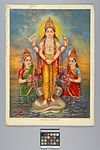About this object
History of use
Indian popular religious prints have been published for nearly a century, first by German presses, later by Indian ones. The prints may take the form of calendars, posters, or simply images. The style of the representations is European. In the beginning they were Hindu images, but are now acquiring elements both of folk art and a romantic secularism. It is a living art currently influenced by the movie industry and non-Hindu religions. The images are a vehicle for advertising and are also used for religious purposes. This image was printed in Germany for the South Indian market, then framed and displayed in a prayer room for 'puja' or worship.
Narrative
From collection of calendar prints collected in southern India.
Cultural context
popular religious art
Iconographic meaning
Vishnu, preserver of the universal order, establishes law and order and protects the world from evil and destruction through ten earthly incarnations. He is identified by: rotating discus; six-petaled lotus; mace symbolizing his power of knowledge; white conch shell; gold crown; and his flying mount, Garuda.
Physical description
Rectangular calendar print depicting Vishnu, a four-armed male adorned with necklaces, bracelets, earrings, armlets and in a gold crown with yellow sunburst halo shape behind. He is wearing yellow and orange dhoti; floor-length from waist. He stands on top of rounded globe with cobras coiled around circumference. All float in blue green lake. Vishnu is flanked by two women wadding in the water; one in a green sari, the other red. Each holds a pink, red and green flower bouquet. Mottled blue and orange sky background. 'Printed in Germany', 'Sreeman Narayana' and 'Coconada 1928' written on print.
Categories
Materials
